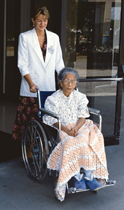

Social and Economic Factors
 Within the next ten years, the US population will grow significantly older and more diverse. The minority older population will triple by 2030, when one quarter of the elderly population will belong to a minority racial or ethnic group (US Census Bureau, January 2000). Different racial and ethnic groups have diverse beliefs and attitudes about health and medicines, which may affect adherence to therapy.A failure to appreciate these differences may contribute to misunderstanding or miscommunication about health care.
Within the next ten years, the US population will grow significantly older and more diverse. The minority older population will triple by 2030, when one quarter of the elderly population will belong to a minority racial or ethnic group (US Census Bureau, January 2000). Different racial and ethnic groups have diverse beliefs and attitudes about health and medicines, which may affect adherence to therapy.A failure to appreciate these differences may contribute to misunderstanding or miscommunication about health care.
No one list can define the values that older adults may place on medications, or their beliefs about how health and healing take place. Each person must be considered individually. Listening and asking nonjudgmental questions begins the process of understanding people's diverse beliefs and practices about health and healing and how to integrate them into interventions to improve medication adherence.
"Culture" refers to integrated patterns of human behavior that include the language, thoughts, actions, customs, beliefs and institutions of racial, ethnic, social, or religious groups (California Endowment, 2003). Every culture has beliefs about health, disease, treatment, and health care providers. People from the many immigrant cultures, as well as American Indians, bring their beliefs, and the practices that accompany them, into the health care system. This often proves challenging to health care professionals who have been trained in the philosophy, concepts, and practices of Western medicine (California Endowment, 2003).
People within any cultural group are not homogeneous, even though they may hold many beliefs, practices, and institutions in common. Messages and materials must respect the variations within cultural groups. Some of the major areas of difference within groups include educational level, English language proficiency, financial resources, adherence to folk customs and beliefs, sexual orientation, geographic location, health status, and preferred language.
In cultures where elders receive great respect, such as in the American Indian community, caring requires kindness and respect without any appearance of scolding (Salimbene, 2005), even if non-adherence may endanger the elder's life. Trust-building comes with storytelling, listening, respecting silence, and honoring the desires of the American Indian elder (University of Washington, 2005). Because of the experience of many African American elders who grew up with segregated health care and social service systems in which they faced continual discrimination, it is extremely important to show respect to them in order to put them at ease and establish rapport. This includes at the least, using respectful forms of address (e.g., Mr., Mrs.) unless they give the permission to do otherwise (University of Washington, 2005).
Based on personal history and experience, many African Americans may view receiving health care as a degrading, demeaning, or humiliating experience. Some may even fear or resent health clinics because of the long waits, medical jargon, feelings of racism or segregation, loss of identity, and a feeling of powerlessness and alienation in the system (Spector, 2000).
The African American experience in America has left many African Americans mistrustful of mainstream institutions and providers who are members of the dominant culture. The 40-year Tuskegee Experiment, which recruited African American men with syphilis to be a part of a research project in which they were promised but never given treatment, is notorious in the African American community. Memories of such practices, in addition to the widespread discrimination most have faced in their lifetimes, are likely to provide reasons for African American elders to be more than a little suspicious of health care providers, especially those who suggest any type of experimental treatment or research (Stanford University). In the American Indian or Native American culture, there is historical mistrust of mainstream institutions due to centuries of abuses such as broken treaties and forced relocations. Acknowledging this history is an important step in building trust with the person and their family (University of Washington, 2005).
Religion, spirituality, and kinship ties may have an important role in older adults' understanding and treatment of illness. Some older adults may view illness and death as a natural part of life, or believe illness is a result of natural causes, improper diet or eating habits, exposure to cold air or wind, the will of God for improper behavior, or a lack of spiritual balance. Some older adults may delay seeking medical care, preferring self-treatment and giving God a chance to heal, or may seek care from folk healers, lay advice, home remedies, and prayer to treat illness.
For example, the Latino older adult may see illness as an imbalance between internal and external forces, and may seek medical care from folk healers (University of Washington, 2005). Many American Indians believe that harmony among the body, heart, mind, and soul contributes to one's overall health (University of Washington, 2005), and that illness may be caused by the breaking of sacred tribal taboos, unhealthy relationships with humans or nature, or by witchcraft (Salimbene, 2005). The person may turn to Western medicine for treatment of the symptoms of illness, but may also seek traditional healers to address the disharmony that caused the illness (University of Washington, 2005). In Hinduism the law of cause and effect (karma), which one creates through thoughts, words, and deeds, may result in illness or accidents as a means to purification. Karma is believed to accrue over many lifetimes; hence, an illness may be seen as a result of actions in this life or a past life. Acceptance of one's karma may influence a person's attitude toward medical intervention (University of Virginia, 2004).
In the Chinese culture, health may be viewed as finding harmony between complementary energies (called yin and yang), such as cold and hot, or dark and light (University of Washington, 2005). Cultures following Chinese or Ayurvedic health beliefs may try traditional approaches to treating illness first, such as using foods and herbs to restore yin/yang balance, and will seek Western medical care if these treatments fail. The traditional systems of medicine are believed to remove the cause of the illness, and therefore, some Asian ethnic groups rely on traditional remedies for long-term treatment (Institute for Safe Medication Practice, 2003).
Older adults in some cultures, such as Chinese, Vietnamese, and Latino, are more likely to try home therapies, such as herbal remedies or certain foods, before trying traditional Western medicine. If a person believes the health care provider may disapprove, they may not be forthcoming with information about the use of nontraditional remedies. This may result in drug-food or drug-drug interactions with prescribed medications.
Cultural beliefs may also dictate how medical information is disseminated or received. For example, in some Arab cultures it is preferable for a family or community member to act as a "buffer," communicating directly with the health care provider and then discussing findings with the patient. In the Latino culture, the mother determines when a family member requires medical care; the male head of the household gives permission to seek medical care (University of Washington, 2005). For other cultures, more than one reliable source must provide the information, such as a doctor, spiritual leader, or family elder.
For some people the size and color of the medication, or the dosage form, may be important. For instance, some Cambodians equate pill size with potency; a large tablet may be thought of as too large a dose. This example is similar to the common, but erroneous, Western belief that a greater number of milligrams (mg) in a pill or capsule make a medication stronger. Chinese older adults may believe that Western medicine is too strong and may not take the full dose or complete the course of treatment (University of Washington, 2005). Some cultures from Latin America view injections as more effective than oral medications (Institute for Safe Medication Practice, 2003). In some countries, medications are in short supply, so prescribing smaller amounts may be the norm; if people from these countries do not clearly understand the role of chronic medications, they may discontinue them prematurely (Tobias, 2003).
When considering cultural communities, the Lesbian, Gay, Bisexual and Transgender (LGBT) community often is forgotten. Approximately 10% of the older population identifies with LGBT concerns. It is important to distinguish between gender identity (male, female, transgender) and sexual orientation (lesbian, gay, bisexual). The sexual orientation of transgender people may fall anywhere within the range exhibited by nontransgender people (i.e., lesbian, gay, bisexual).
Trust in the provider can attract or discourage LGBT older adults from acting on health messages and adherent behavior. Two actions generating trust and credibility include the use of welcoming language, and respect for privacy and confidentiality. Using terms such as partner instead of family, and avoiding heterosexual-relationship terms (e.g., married, family, husband/wife) engenders a greater feeling of trust. Many LGBT people have experienced discrimination and sometimes violence. Targeted messages must convey a nonjudgmental stance, respectful of individual preferences and identity. An appropriate tone should impart a safe environment, especially if the message promotes services, courses, or community activities.
The Office of Minority Health, in the U.S. Department of Health and Human Services, has developed National Standards for Culturally and Linguistically Appropriate Services in Health Care (CLAS Standards). The 14 CLAS Standards serve as a guide to quality health care for diverse populations, and include a recommendation that health care organizations ensure cultural competence in their professional staff by offering them education and training in the field. The CLAS Standards, along with an in-depth discussion of how they were formulated, are available at www.omhrc.gov/assets/pdf/checked/finalreport.pdf (US Department of Health and Human Services, 2001).
No one becomes culturally competent overnight or with one or two hours of training; certain attitudes need to be learned, skills transmitted, and knowledge absorbed (California Endowment, 2003). Cultural competence training often involves attitude changes and the examining of personal biases and stereotypes as an initial step to acquiring the skills and competencies necessary for quality cross-cultural care, which requires careful guidance and skillful group facilitation (California Endowment, 2003). Skills that enhance a health care providerís ability to recognize different cultural values, beliefs, and practices and to address these factors in interventions are likely to lead to more successful treatment outcomes (Bonder et al., 2001).
General knowledge about specific cultures can increase understanding; however, a fact-centered approach risks replacing one stereotype with another. The new stereotype may be more positive but still fail to capture the complex nature of an individual's culture. Often, information taught as cultural awareness isn't as generalizable as it seems, and cultural beliefs and behaviors are ever changing (Interplay, 2005).
| BARRIER | STRATEGIES |
|
Cultural beliefs
|
Establish a positive, supportive, trusting relationship with the person
Seek an understanding of the causes of illness from the person's cultural point of view
Elicit information about use of nontraditional therapies in non-judgmental way
Determine person's preference regarding group learning or individual, private instruction
In providing information consider:
Acquire the skills and competencies necessary for quality cross-cultural care
|

